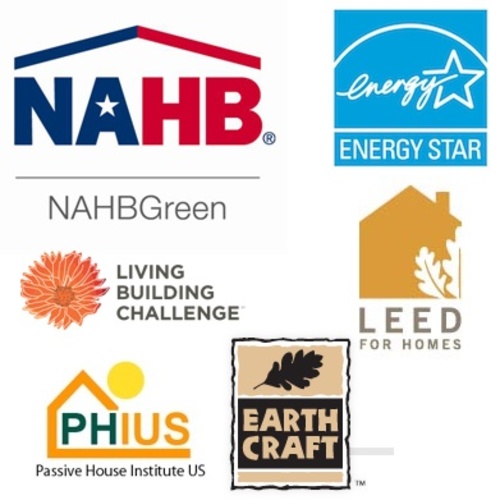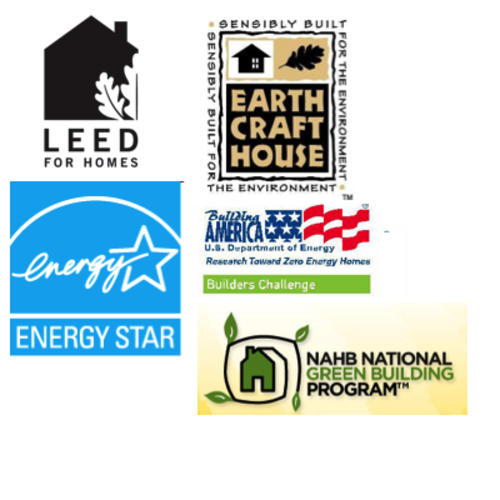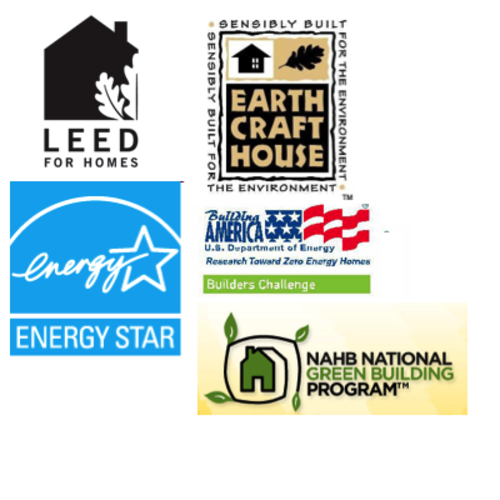
Among other endeavors, I have been certifying LEED homes as a provider representative for about two years now. In order to continue doing this work after next year, USGBC and GBCI have decided that I must become certified as a green rater. After looking at my various options for obtaining this designation, I elected to take a two-day training class in advance of the required test. Not uncharacteristically, I bristled at the thought that I would have to spend my time and money learning something I was already doing. To my surprise, the class, taught by Laura Capps and Kevin Stack, was both informative and engaging. I picked up on a lot of small details about the program and believe that I gained additional knowledge that will help me do a better job certifying homes under the program.
OK, enough praise
As these thoughts drifted in and out during the class, a question occurred to me: if you are insane, can you be aware of it? I think that some green building programs in general don’t always have a firm grasp on reality and are veering off into their own versions of insanity. Two days of training on the intricacies of LEED for Homes, while answering many questions, also raised more. The program continues to get more complicated rather than less, which I believe is the wrong direction. We need to make green building simple while not watering it down, something that many people believe is possible.
Roadkill redux
The industry and the general public are wrestling with about 100 different programs representing cities, counties, regions, and the entire country. As I discussed in an earlier post, various programs are fighting each other for market share, causing confusion for everyone including the general public, the building industry, and green building experts. I am concerned that the combination of too many competing programs and their increasing complexity may lead to a backlash from consumers before the market settles on one, or a few “winners.” On top of this, the 2009 IECC and Energy Star 2011 are coming down the pike, creating conflicts with various programs that need to change just to keep up.
Is anyone listening?
While I have my issues with all green certification programs, including LEED, I appreciate that as a group they are continually raising the bar on home construction and renovation, in addition to providing me with ongoing work and income. But have they lost their way and become stuck in their own realities, or unrealities, as the case may be? I don’t believe that these programs need to be as complicated as they are. I think sometimes that program developers are sadists who sit in underground rooms conspiring new and different ways to torment the people trying to certify buildings. All I can say is, I hope those people are reading this and taking my plea to heart.
Weekly Newsletter
Get building science and energy efficiency advice, plus special offers, in your inbox.















6 Comments
Green Building Program Deafness
Many are listening, most agree;apparently, none of those are running a green certification program.
One more thing
It was brought to my attention after I posted this that EarthCraft House (www.earthcrafthouse.com), available in the Southeast US, is a very comprehensive, easy to use certification program. I agree that EarthCraft does have a nice balance of simplicity and rigor that many others lack. That said, I don't think there is a single program out there that wouldn't benefit from some careful review and simplification. I just heard a comment from a fellow soon to be green rater that few of the people creating programs seem to understand that simplicity will expand adoption.
Agree wholeheartedly
Carl - As you know, I couldn't agree more with your comments. As a practicing (but not "certified") Green Rater, I often wonder, "if this is difficult for me to understand as a high performance builder and "green rater", then how can the average builder, not to mention the average consumer, possibly understand the details and differences between these programs?" I have seen the level of confusion and mis-information run rampant over the past 18 months in builder/supplier circles and amoungst consumers. In some cases, the mis-information is so great, that people are turning away out of sheer frustration, or taking the wrong path by following bad advice from a mis-informed vendor, supplier, or builder.
While I also applaud these programs for raising the bar in an industry in great need of a quality "paradigm shift", I do feel that a straightforward, practical approach to "green" would be refreshing for those currently involved in the movement and would result in more rapid adoption of green practices across the industry.
These programs need to evolve in a "sustainable" fashion (to use the term) - the KISS approach, crawl - walk - run, etc.... They should not be designed and re-designed in a bubble, but in a fashion that considers the realities and drawbacks of constantly changing the programs without providing the infrastructure and support.
A Very Tricky Balance
Looking back on the last 8 years with writing our local voluntary residential green building program, I too learned that the best way to encourage participation was through simplicity. Our first program launched in 2003 consisting of 23 pages. Despite our 18 month writing process with the help from area builders, utility companies, and green building experts from national labs, we were very disappointed that so few builders went through our certification process in our first year. Subsequent surveys of builders came back with them saying, "Stephen, you know I'm going to build with non-FSC wood framing on a slab-on-grade. Given that, you tell me what I need to do to meet your minimum requirements to get a certificate." That gave birth to our Level 1 Program, which consisted of a list of 32 prerequisites that had to be met. Flexibility was still a part of the program with the ability to make substitutions for some of the prerequisites if needed based on the value of other options found in our original program. We found it critical that the program had simplicity at its core to earn participation, but we strove to make even this Level 1 program rigorous enough to be considered a legitimate program in the eyes of green building professionals and not be dismissed as greenwashing.
It's important to provide programs that are simple to understand and not difficult for builders to execute, but it's also important to not simply provide builders with a list of fifty options and tell them to choose any ten they want to use to be certified. Keeping it simple and keeping it legit is a very tricky balance. However, there are many good examples in place, and I would be surprised if most if not all meaningful programs did not require a particular HERS Index benchmark (linked to ENERGY STAR), and incorporate other national guidelines such as EPA's Indoor airPLUS, and WaterSense. For those who are writing or updating local green building programs, an understanding of these is a good foundation.
It requires vigilance keeping ahead of the changing building codes, the upcoming ENERGY STAR 2011, and breakthroughs in technology, but in service to the general public, keeping the programs legitimate demands nothing less.
yes but..
I have a lot of thoughts on this sunject as readers of my blog already know, and I think that it is essential that we create a simple and elegant path to achieve a level of adoption and change in culture that will be impactful. I don't see anything in EnergyStar, HomeSmart, LEED, EarthCraft that approaches that level. Much of that stems from an overall lack of metrics (even energy doesn't have a good metric that is aligns with behavior change), a fascination with finding justifications rather than demanding best practices, and a general lack of understanding about the primary and secondary users of the programs (homeowner & remodeler/builder)
sent from my palm pre with tiny keys and no spell check
The Intent of Green Certification
I have been doing a lot of work recently with businesses and a local green business certification program as well as work certifying residential homes in programs like LEED. Trying to communicate the higher-level intent of green building and the importance of 'sustainability' has been the hardest market issue since folks are motivated to join the program for a variety of reasons. Everything from truly wanting to become more environmentally and sustainable-conscious, trying to promote yourself as a builder or business that is 'better' than the average, and simply keeping up with the Jones are all motivational factors. Sometimes doing everything possible to become the 'greenest' building doesn't really align with these factors even though a person is motivated to start down the path.
The intent of all these programs is obviously to build more efficient and 'better' structures though the pathway and options to achieve this can and will vary greatly at times. Getting stuck on the points or credits of a program happens frequently because of this and the greater intent can be lost very easily. As a industry I believe we need some consolidation not of the platinum and emerald trinkets associated with green building but rather of the intent of why certain 'green' measures and concepts are so vitally important to incorporate into design.
Buildings that are only 15% better than code (which may not even meet energy code in the next few years updates) still achieving high levels in these programs adds a faux level of greenwashing that folks uneducated in the industry can't recognize. I don't want it coming back and biting us later down the road. I want the intent of quality construction practice and environmentally conscious building design to be more important than gold stars coming from arbitrary programs tweaked to favor certain types of construction.
Log in or create an account to post a comment.
Sign up Log in